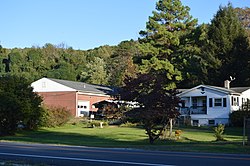Bent Creek Bentcreek, Duguidsville | |
|---|---|
 House and general store on State Route 26 | |
| Coordinates: 37°32′06″N78°49′37″W / 37.53500°N 78.82694°W | |
| Country | United States |
| State | Virginia |
| County | Appomattox |
| Elevation | 417 ft (127 m) |
| Time zone | UTC-5 (Eastern Time) |
| • Summer (DST) | UTC-4 (Eastern Daylight Time) |
| ZIP code | 24553 |
Bent Creek is an unincorporated community in Appomattox County, Virginia, United States.


